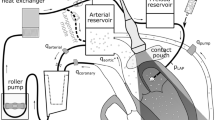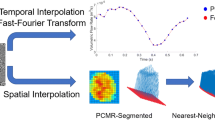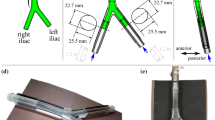Abstract
The total cavopulmonary connection (TCPC) is currently the most promising modification of the Fontan surgical repair for single ventricle congenital heart disease. The TCPC involves a surgical connection of the superior and inferior vena cavae directly to the left and right pulmonary arteries, bypassing the right heart. In the univentricular system, the ventricle experiences a workload which may be reduced by optimizing the cavae-to-pulmonary anastomosis. The hypothesis of this study was that the energetic efficiency of the connection is a consequence of the fluid dynamics which develop as a function of connection geometry. Magnetic resonance phase velocity mapping (MRPVM) and digital particle image velocimetry (DPIV) were used to evaluate the flow patterns in vitro in three prototype glass models of the TCPC: flared zero offset, flared 14 mm offset, and straight 21 mm offset. The flow field velocity along the symmetry plane of each model was chosen to elucidate the fluid mechanics of the connection as a function of the connection geometry and pulmonary artery flow split. The steady flow experiments were conducted at a physiologic cardiac output (4 L/min) over three left/right pulmonary flow splits (70/30, 50/50, and 30/70) while keeping the superior/inferior vena cavae flow ratio constant at 40/60. MRPVM, a noninvasive clinical technique for measuring flow field velocities, was compared to DPIV, an established in vitro fluid mechanic technique. A comparison between the results from both techniques showed agreement of large scale flow features, despite some discrepancies in the detailed flow fields. The absence of caval offset in the flared zero offset model resulted in significant caval flow collision at the connection site. In contrast, offsetting the cavae reduced the flow interaction and caused a vortex-like low velocity region between the caval inlets as well as flow disturbance in the pulmonary artery with the least total flow. A positive correlation was also found between the direct caval flow collision and increased power losses. MRPVM was able to elucidate these important fluid flow features, which may be important in future modifications in TCPC surgical designs. Using MRPVM, two- and three-directional velocity fields in the TCPC could be quantified. Because of this, MRPVM has the potential to provide accurate velocity information clinically and, thus, to become the in vivo tool for TCPC patient physiological/functional assessment. © 2000 Biomedical Engineering Society.
PAC00: 8719Uv, 8761Lh, 8757Ce, 8719Hh
Similar content being viewed by others
REFERENCES
Bluestein, D., L. Niu, R. Schoephoerster, and M. Dewanjee. Steady flow in an aneurysm model: Correlation between fluid dynamics and blood platelet deposition. J. Biomech. Eng. 118:280–286, 1996.
Bryant, D., J. Payne, D. Firmin, and D. Longmore. Measurement of flow with NMR imaging using a gradient pulse and phase difference technique. J. Comput. Assist. Tomogr.8:588–593, 1984.
Chatzimavroudis, G., P. Walker, J. Oshinski, R. Franch, R. Pettigrew, and A. Yoganathan. The importance of slice location on the accuracy of aortic regurgitation measurements with magnetic resonance phase velocity mapping. Ann. Biomed. Eng. 25:644–652, 1997.
Ensley, A., P. Lynch, G. Chatzimavroudis, C. Lucas, S. Sharma, and A. Yoganathan. Toward designing the optimal total cavopulmonary connection: An in vitro. study. Ann. Thorac. Surg. 68:1384–1390, 1999.
Firmin, D., G. Nayler, R. Klipstein, S. Underwood, R. Rees, and D. Longmore. In vivo. validation of MR velocity imaging. J. Comput. Assist. Tomogr. 11:751–756, 1987.
Fontan, F., and E. Baudet. Surgical repair of tricuspid atresia. Thorax. 26:240–248, 1971.
Karn, E., S. Beale, A. Duitino, T. Wei, A. Graham, and G. Nackman. Development of wall surface tangent DPIV measurement techniques for arterial branch models. J. Biomech. Eng. 120:784–787, 1998.
Kim, Y. H., P. G. Walker, A. A. Fontaine, S. Panchal, A. E. Ensley, J. Oshinski, S. Sharma, B. Ha, C. L. Lucas, and A. P. Yoganathan. Hemodynamics of the Fontan connection: An in-vitro study. J. Biomech. Eng. 117:423–428, 1995.
Laks, H., A. Ardehali, P. W. Grant, L. Permut, A. Aharon, M. Kuhn, J. Isabel-Jones, and A. Galindo. Modification of the Fontan procedure: Superior vena cava to left pulmonary artery connection and inferior vena cava to right pulmonary artery connection with adjustable atrial septal defect. Circulation91:2943–2947, 1995.
de Leval, M. R., P. Kilner, M. Gewillig, and C. Bull. Total cavopulmonary connection: A logical alternative to atriopulmonary connection for complex Fontan operations. J. Thorac. Cardiovasc. Surg. 96:682–695, 1988.
Lim, W., Y. Chew, T. Chew, and H. Low. Steady flow velocity field and turbulent stress mappings downstream of a porcine bioprosthetic aortic valve in vitro. Ann. Biomed. Eng.25:86–95, 1997.
Lins, R., M. Lins, C. Cavalcanti, R. Miranda, and J. Mota. Orthoterminal correction of congenital heart disease: Double cava-pulmonary anastomosis. J. Thorac. Cardiovasc. Surg. 84:633–635, 1982.
Meier, D., S. Maier, and P. Bosiger. Quantitative flow measurements on phantoms and on blood vessels with MR. Magn. Reson. Rev. 8:25–34, 1988.
Mitchell, A., and D. Griffiths. The Finite Difference Method in Partial Differential Equations. New York: Wiley, 1980.
Mussivand, T., K. Day, and B. Naber. Fluid dynamic optimization of a ventricular assist device using particle image velocimetry. ASAIO J. 45:25–31, 1999.
Raffel, M., C. E. Willert, and J. Kompenhans. Particle Image Velocimetry. New York: Springer, 1998.
Sharma, S., S. Goudy, P. Walker, S. Panchal, A. Ensley, K. Kanter, V. Tam, D. Fyfe, and A. Yoganathan. In vitro flow experiments for determination of optimal geometry of total cavopulmonary connection for surgical repair of children with functional single ventricle. J. Am. Coll. Cardiol. 27:1264–1269, 1996.
Sloth, E., K. Houlind, S. Oyre, W. Kim, E. Pedersen, H. Jorgensen, and J. Hasenkam. Three-dimensional visualization of velocity profiles in the human main pulmonary artery with magnetic resonance phase velocity mapping. Am. Heart J. 128:1130–1138, 1994.
Willert, C., and M. Gharib. Digital particle image velocimetry. Exp. Fluids. 10:181–193, 1991.
Author information
Authors and Affiliations
Rights and permissions
About this article
Cite this article
Ensley, A.E., Ramuzat, A., Healy, T.M. et al. Fluid Mechanic Assessment of the Total Cavopulmonary Connection using Magnetic Resonance Phase Velocity Mapping and Digital Particle Image Velocimetry. Annals of Biomedical Engineering 28, 1172–1183 (2000). https://doi.org/10.1114/1.1317533
Issue Date:
DOI: https://doi.org/10.1114/1.1317533




